Author Archive

Monday, June 29th, 2015
In the months leading up to Grand Prix Providence, I had to consider if I wanted to judge or play the event. With Grand Prix Charlotte the week before Providence and two seventeen hour drives attached to working for Star City, I started leaning towards playing in Providence. After winning a GPT in Rhode Island for the Grand Prix, I decided with certainty that I was playing in the main event. However, even though I knew I was playing, I still needed to figure out what deck I should run at the event. I had played a lot of Abzan control and even some aggro, but neither deck nor Siege Rhino as a card seemed like the place I wanted to go with a major event on the horizon. I searched the web for an interesting deck and stumbled upon the Grand Prix Shanghai results where one list caught my eye:
Xie Hao Chen’s Green Red Devotion
Planeswalker (10)
4 Xenagos, the Reveler
3 Nissa, Worldwaker
3 Ugin, the Spirit Dragon
Creature (26)
4 Elvish Mystic
4 Rattleclaw Mystic
4 Sylvan Caryatid
4 Courser of Kruphix
3 Polukranos, World Eater
4 Whisperwood Elemental
3 Dragonlord Atarka
Land (24)
11 Forest
1 Haven of the Spirit Dragon
1 Mountain
3 Nykthos, Shrine to Nyx
4 Temple of Abandon
4 Wooded Foothills
60 Cards
Sideboard (15)
4 Genesis Hydra
2 Hornet Nest
4 Seismic Rupture
1 Purphoros, God of the Forge
3 Arbor Colossus
1 Xenagos, God of Revels
This deck list originally intended for my girlfriend Meghan if she decided to play the main event was the basis for the list I eventually settled on for Providence. The deck put a lot of pressure on the opponent to match haymakers with a deck that ran ten Planeswalkers and three Dragonlords. However, a few days before the event I watched a streamer on Twitch.tv named BrettwJayne who I had played against on Magic Online before. He had a take on Green Red devotion that was very close to my list in Providence. The major differences were no Seismic Ruptures in the sideboard and two Deathmist Raptors in the main. I had seen many people play Raptors in the main and it never made sense to me as the deck accelerates past the early game where Raptor is a roadblock and tries to jam huge threats repeatedly that the opponent cannot deal with profitably. After taking out the Raptors and compromising on the number of Ruptures and Nylea’s Disciples in the sideboard, I came to the list I sleeved up at the Grand Prix:
Planeswalker (4)
2 Xenagos, the Reveler
1 Nissa, Worldwaker
1 Ugin, the Spirit Dragon
Creature (32)
4 Elvish Mystic
4 Sylvan Caryatid
4 Rattleclaw Mystic
4 Courser of Kruphix
3 Polukranos, World Eater
4 Whisperwood Elemental
3 Dragonlord Atarka
2 Hornet Queen
4 Genesis Hydra
Land (24)
1 Haven of the Spirit Dragon
1 Mountain
11 Forest
4 Temple of Abandon
4 Wooded Foothills
3 Nykthos, Shrine to Nyx
60 Cards
Sideboard (15)
1 Xenagos, the Reveler
2 Nissa, Worldwaker
2 Ugin, the Spirit Dragon
2 Plummet
2 Hornet Nest
2 Seismic Rupture
2 Nylea’s Disciple
2 Arbor Colossus
This version of the deck focuses a lot on high-end threats and rushing them out before the opponent is ready to fight on that axis. The reduction of main deck Planeswalkers was a choice I felt unsure about, but being able to board up to 9 Planeswalkers against control decks was one of the main draws of this version. Having a few one-of cards like Ugin or Nissa also played a pivotal role in stealing some important game ones where the opponent could not react to such a potent threat along with the other heavy hitters like Hornet Queen or Dragonlord Atarka. After rushing to get my last few Genesis Hydras for the event, I had my 75 submitted and sleeved up ready for day one.
I arrived for Day one at 10:45 as I had two byes and a sleep-in special. However, as I signed in with the people at the stage it was evident that the tournament was running slowly as it was still round one. After grabbing a quick bite to eat and catching up with my friends who did not have byes or the sleep-in special round two was quickly ending and I was ready to do battle.
In round 3, I played against Sean Morgan who claimed not to play much standard as he liked legacy far more. He stated that he wanted to play a deck he could have fun with and after he lost the die roll, we began our match. He was playing Atarka Red and I was a turn slow as he finished me off with Lightning Strike, Lightning Strike. The sideboarding for this matchup is very straightforward and the only hard part is figuring what big drops have to stay in despite not being very good.
+2 Nylea’s Disciple
+2 Hornet’s Nest
+2 Seismic Rupture
-1 Ugin
-1 Nissa
-2 Rattleclaw Mystic
-2 Hornet Queen
Despite Hornet Queen being very powerful if it resolves, it does not sweep the board as well as Atarka and in games where they are stuck on mana, killing creatures to eliminate Stoke the Flames as a card is very powerful. Game two started with a Caryatid into a Seismic Rupture to slow him down while also playing a post Rupture Elvish Mystic. Next turn I deployed a Whisperwood Elemental; the next turn, another Elemental; and the next turn one more for good measure. Despite the first and second one eating Stoke the Flames after getting a manifest, I was too far ahead and swung in for lethal while he shows me eleven points of burn stranded in his hand. For game three, he started on the play and removed my elf. His hand was very slow and he ended up stuck on lands while I started deploying threats. He eventually conceded with a hand full of gas that he never cast. While every game felt close, in the end I was able to survive the onslaught of Atarka Red and move to 3-0.
Next was William Dziambor on Abzan Control, which was fantastic for me and not so great for him. Going into this weekend I saw Abzan as a bye, which given I faced it seven of the fourteen rounds I played in the Grand Prix was a blessing. William was a nice guy from Canada who knew the matchup was bad and had fun playing Magic despite knowing that after turn four or five the game was heavily in my favor. Both games involved some removal and many Siege Rhinos, but when playing Ugin and Atarka, a crash of Rhinos seems a lot weaker. Even with End Hostilities in game two, it was not close and I quickly pulled to 4-0.
+2 Ugin
+2 Nissa
+1 Xenagos
-2 Polukranos
-1 Courser
-2 Rattleclaw Mystic
Something that came up often during the Grand Prix was the idea of siding out one of a card that was not bad for a strict upgrade in the matchup and based on my sideboarding, it is clear to see when a random one-of comes out for a card that does better in that slot. Even though Courser is good in this matchup, keeping one Polukranos seemed better than the fourth Courser. Little swaps like this really take time to figure out when all of something or one of a few things is better to remove and it comes with reps with the deck.
In round five, I played against Jason Chung of New Zealand and as it turns out, Jason was one point away from Platinum. This was the first time in the event I was playing someone who I would consider either a pro or a name made through good event finishes. Jason was playing Mardu Aggro and was a generally very nice person. Game one I was on the draw and he got off to a quick start with Swift Spear into Seeker of the Way. On Turn four, he tapped out and played an Outpost Siege choosing to deal one damage to either my creatures or me any time his creatures died. I then played a turn four Atarka, wrathed his board and we quickly moved to game two. I sideboarded very poorly for game two and will not show the boarding choices as they were very bad. I was punished as he bowled me over quickly and I never really had the chance to react to his game plan. For game three, I boarded correctly:
-2 Rattleclaw Mystic
-1 Ugin
-1 Nissa
-1 Genesis Hydra
+2 Hornet’s Nest
+2 Nylea’s Disciple
+2 Seismic Rupture
Game three I played very patiently making him play removal spells on creatures I did not care about and making his Anger of the Gods poor as it would only one for one. Slowly I was able to find lands and cast bigger and bigger threats while he was stuck on reactive answers and when he ran out of answers, I just kept casting Whisperwood Elementals and Atarka until I was 5-0 and defeated a far more renowned player.
In Round six I played against Jarvis Yu whose name I knew from the SCG Open circuit. Once again, after seeing Abzan colored lands, I knew this would be a good matchup for me. While not much was very different about this match than from my earlier opponent William Dziambor, I read Jarvis’ deck as Aggro after seeing Rhino into Wingmate Roc with removal in game one. I sideboarded terribly and Jarvis was nice enough to help me out and correct my boarding in case I played against Abzan Control again, 6-0.
In Round seven I played against Dan Jessup who I also knew played on the SCG Open circuit often and would be a solid opponent. However, once he led with an Abzan land again the match felt easy. He was on Abzan Meghamorph, which is a little slow and without adjusting his removal suite to deal with GR Devotion specifically the matchup felt very much in my favor. I will be honest, I drew pretty well and the games were very one-sided, but I did not expect such a negative and tilted response from a veteran player who lost their first match to a very bad matchup. Titling off happens, but do not do it in front of your opponent, your results are not the only thing going on at a tournament 7-0 and locked for day two.
-2 Rattleclaw Mystics
-1 Courser
-2 Polukranos
+2 Ugin
+1 Xenagos
+1 Nissa
+1 Hornet’s Nest
Round eight was my first feature match and it was against Pascal Maynard who had recently top 4ed Grand Prix Las Vegas and was a big name player. Our game one ended very quickly as he was playing Abzan Megamorph and I went too big too fast and he died. Our second and third games are on Twitch.tv/Magic2 and I was quickly dispatched in game two after stumbling on resources and not finding enough gas to overpower him. Game three was a fantastic game that culminated in an Ugin -2 clearing the way for Nissa to take over the game and a missed Scry trigger from Pascal that sealed his fate. Although I feel bad about him missing his trigger, even in a high-pressure situation the smallest mistake can cost you a tournament 8-0.
We were the last match playing in Round eight due to an eighteen-minute extension where we used almost all of those bonus minutes. After rushing to the pairings boards to see whom I was playing next, it turned out I was paired against Josh McClain of Canada who was a fantastic player and an overall nice person. Game one, despite him being on Abzan Megamorph, was very tough and three Den Protectors and an Elspeth later I was down a game. I made a major mistake of chipping his first Elspeth down to three forgetting about the minus ability cleaning up my Polukranos when I could have hit with one more Hornet to put her to two. This was the first big misplay to cost me, and as I said, any one mistake can cost you when playing against players of Josh’s caliber. Game two I was able to stabilize against his slightly faster start and then cast an Atarka and Ugin to go over the top. After ultimating Ugin and finding a replacement, he conceded. Game three was rough as I took my first mulligan of the tournament and found Courser, Genesis Hydra, Atarka, Xenagos, Forest, Nykthos. With a dork on the first three turns or a green land, I could at least compete so I kept. My next draws were Ugin, Atarka, Mountain, Genesis hydra and I died to Josh’s board 8-1. While I wish I could have had a real game three against Josh, I kept a hand that had a real issue, and since I did not draw well I was punished. Either way, 8-1 was quite a good start going into day two.
-2 Rattleclaw
-1 Courser
-2 Polukranos
+2 Ugin
+1 Nissa
+1 Hornet’s Nest
+1 Xenagos
Day two started with a New England end boss who I had played a few times and had never beaten in sanctioned Magic, Mike Sigrist. After telling me he had been sick and pumped full of medicine over the night I was wishing him well in the game and outside. Mike was on Abzan Megamorph, the same list as Josh, and despite adding extra Ultimate Prices to deal with GR Devotion, I was able to take over game one quickly. In game two, he was stuck on four lands and was not able to pull the trigger on an End Hostilities dying with many cards in hand, but not much on board 9-1.
Round ten was another example of me being a bit dumb about what my opponent was playing. I sat across from Richard Tan who led with two G/B Wastes, Forest, Island, Deathmist Raptor, Sidesi, which hit Satyr Wayfinder, and three lands. I thought he was on Sidesi Whip and once again sideboarded very incorrectly. After realizing he was on G/B Five color dragons and that there were no Plummets or Arbor Colossus in my deck, the matchup seemed a lot harder. However, I was able to win by grinding through a Disdainful stroke and flipping an Atarka off my one Whisperwood Elemental trigger. After untapping with seven mana, I played around Stroke by flipping Atarka and putting him to four. This forced him to tap out to play Dragonlord Silumgar and take my Atarka. I miracled a land to cast Ugin and -6 to wrath the board except for my Ugin and my Atarka and he conceded 10-1.
After Round ten I overheard people talking about the cut to top 8 being at 12-2-1 and after checking the standings I was ranked third going into the next round. I was ecstatic that I had a real chance of top 8ing the GP and making the Pro Tour. I walked to the pairings board and found my name across from Andrew Tenjum, who I knew was playing Abzan from his match against Noah Walker the day before right next to me. After sitting down and chatting for a few minutes, I played my first land and pulled ahead with threat after threat that his Abzan control deck could not handle as he was stuck on lands game one and flooded game two 11-1. Even though it was not the most eventful set of games, it meant I only needed one more win in the next two and I could draw into top 8.
Round twelve saw me paired against Kevin Sauls whose name I did not know, but as soon as I sat down, I recognized him as one of the players in the top tables on day one. We sat down and started chatting and it turns out it was Kevin’s first Grand Prix and he is a super nice person. It was a pleasure to play the mirror against him in a Win-and-in. I took game one on the back of some big spells and finally got to board in some of my less used cards.
-2 Rattleclaw Mystic
-1 Courser
-1 Polukranos
-1 Nissa
+2 Ugin
+1 Xenagos
+2 Arbor Colossus
Game two he rushed out a Xenagos into Ugin and I died not drawing enough gas early when I had mana and too much gas after he killed all of my dorks. This is how the mirror works, sometimes they turn four Atarka and you are just dead. Game three we each had semi explosive hands and we clogged up the ground. I was able to find haymaker after haymaker while he kept manifesting his and eventually he extended the hand when I threatened to Polukranos for a massive amount wiping out his board and crashing in for lethal. Kevin was a nice person and I hoped he would be able to make top 8, but unfortunately he was in the mirror again the next round. I, on the other hand, was now 12-1-0 and the top ranked player in the tournament.
Round Fourteen saw me paired against Oliver Tiu who would end up being my quarterfinal opponent. We decided to draw as the two 36 point players paired at table one 12-1-1. Round Fifteen, I was paired against Neal Sacks who I would play in the Finals as we both drew into our first Grand Prix top 8s with a handshake and a hug 12-1-2.
I was the four seed in top 8 and paired against the five seed Oliver Tiu who was on G/B Five color dragons. Unlike Richard I got to see his list before the match and realized that game one seemed pretty easy and game two he had access to no counter magic. With that realization, it was very easy to just jam threat after threat and keep a little slower hands as he needed time to set up. Despite getting to bring in Plummets, the games were over very quickly as I ramped hard and overran him with much bigger creatures faster than he could handle 13-1-2 and into the semis.
The Semifinals was much harder as I was against Pedro Carvalho with Sultai Whip, which was about a 57% matchup in my mind as I told friends as they walked by asking how top 8 was going. From this point, forward the matches were on Twitch and I will only talk about interesting moments or decisions.
-2 Rattleclaw Mystics
-2 Polukranos
-1 Courser
-1 Nissa
+2 Ugin
+2 Arbor Colossus
+2 Plummet
Game two I kept a land light hand with two dorks and I wanted to run out one and hold the second in case of Drown in Sorrow. I ended up missing my third land drop and played out the Rattleclaw Mystic. He had Drown. I was punished and conceded shortly. Game three was much more interesting as we both had some game, but there were two talked about points in the match. First, I did not sacrifice my Whisperwood Elemental in response to Crux of Fate knowing I would draw a Genesis Hydra. I did not want to run into Drown and drawing Hydra and possibly reloading the board seemed better to me than getting two 2/2s. Second, after Pedro cast Dragonlord Silumgar taking Ugin I was unsure if he was going to -9 or +2. After realizing that his last card was likely Murderous cut because he did not Thoughtseize me and he only had B up, I felt his line of trying to ultimate Ugin was correct. However, since I had a second Ugin I had sandbagged since my opener, I knew I could get Ugin back, but as Pedro said, Plummet would be game as I would get back Ugin and have a backup for after ultimating the first Ugin. I drew the Plummet, made sure to think through both lines and showed him the Plummet and I was into the Finals 14-1-2.
My finals opponent Neal Sacks was a nice person who was willing to chat and have a laugh despite the gravity of the situation and I really appreciated that. The finals were rough as he absolutely smashed me with a savage Dromoka’s Command play and I died quickly in game one.
-1 Nissa
-1 Ugin
-1 Rattleclaw Mystics
-2 Genesis Hydra
+2 Hornet’s Nest
+1 Xenagos
+2 Nylea’s Disciple
Game two I was able to hold on and stabilized until Atarka showed up. There was the big Siege Rhino backup, which I feel Head Judge Kevin Desprez handled very well, and after correcting the board state, we finished the game. Going into game three, I was tense as it was a best of one for the title and everything along with it. I kept my hand of Scry land, four other lands, Xenagos, Whisperwood after he mulliganed since I figured I would have some time and three draw steps including the Scry to find a dork. Neal ended up mulliganing down to four cards and I drew an Elvish Mystic on turn one. Once I got to block down his creatures and he did not have a trick I knew that I had won; which did not help after looking at extra cards after my courser died. After attacking for a large chunk, Neal fetched, drew, and passed. I made another Satyr and won a Grand Prix, 15-1-2.
The scream of my friends behind me and all around was amazing and after talking about testing together for the Pro Tour, I was whisked away to give a winner’s interview with Marshall Sutcliffe. The whole coverage team was fantastic and I had a blast having brief conversations with them after locking top 8 and waiting on my top 4 match. The interview was a lot of fun and all of the photos, hugs, and congratulations were a fantastic topping to the experience of actually winning a Grand Prix. Moving forward I feel the deck is still well positioned, but now it’s higher on people’s radar and more mirrors and Perilous Vaults have shown up on Magic Online. If the Meta has shifted a little too hard from Abzan to Vaults and counter magic, sleeving up RG Dragons or Atarka Red seems like a good decision. As of writing, I am happy to say that the dream of wining Grand Prix Providence has finally started to sink in as reality and it was just as amazing as expected.
Posted in Blog, Card Games, Events, Featured Post, Magic: The Gathering | 1 Comment »

Monday, September 29th, 2014
We’ve decided to do a little project for fun. It’s been something we’ve been joking around about at the store for a while now, and every time it gets mentioned things usually get hilarious pretty fast.
The idea is to build a set of Magic: The Gathering cards themed after Battleground Games & Hobbies and the people who make up the community. We want the cards to be playable (for the most part) and also be a good representation of the person or thing we’re trying to emulate, honor, and sometimes poke fun at.
We’ve tentatively decided to call this project “Battleground: The Gathering Place,” and we’ve put together a team to formulate ideas. The goal is to try to release a new card on the Battleground blog each week. Maybe when we get to 300 cards we’ll actually print the set and see how it plays in a cube draft or something to that effect.
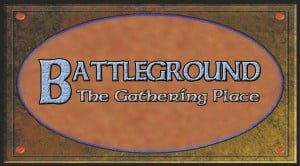
In the meantime, we will start off with a very sensible choice. I present to you, Battleground: The Gathering Place’s first official card of the series:
Chase, the Mind Sculptor!
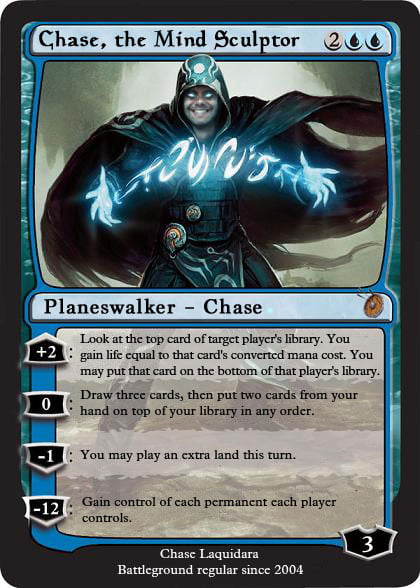
Is it broken? Sure, a little bit. But so isn’t Chase.
What do you think of our first card?
How can you get involved? We’re glad you asked! Follow the project on Facebook, Twitter & Instagram; and/or contact us here to suggest cards. And of course, sound off in the comments below and let us know what you think.

Tags: Altered Cards, Battleground Games & Hobbies, Community, Custom Cards, Magic the Gathering, Special Project, The Gathering Place
Posted in Blog, Card Games, Featured Author, Magic: The Gathering, Store Related | No Comments »

Monday, June 30th, 2014

When the fifth edition of Dungeons & Dragons releases on July 3rd, I will have been playing the game for thirty-two years. I suppose this should make me feel old, but it doesn’t. I’ve played my way through every edition of the game, in all of its many forms and styles, and I’m really looking forward to this next incarnation.
Clearly, not all editions were created equal. To be sure, each had their highs and lows; their strengths and weaknesses. Yet, no edition can match the level of division in the gaming community that 4th edition managed to create. I experienced this division more intensely than most people, perhaps, because of my profession as a game store owner. It’s my job to share my opinion on products, and to listen to the opinions of others on the subject. How many comments, debates, and arguments have I been in over the last dozen years about which edition was best and why? What makes for a good game and what is sure to ruin one? Was THAC0 a good thing? I feel as though the long journey through (what will soon be five editions, plus one variant edition, and at least two important sub-editions) has brought me to a place that I am fairly confident in my ability to answer those questions – at least as the game pertains to me.
The early years
In 1982, my first experience with Dungeons & Dragons was with a friend who practically had to twist my arm to try it. I think back now how funny that was, considering the life-long path that my first experience with the game would propel me down. My reluctance to play nearly prevented me from trying it, and I still owe thanks to my friend Jacob Graham for his perseverance and insistence that things would be fun as soon as we finished rolling up that character. He was right.
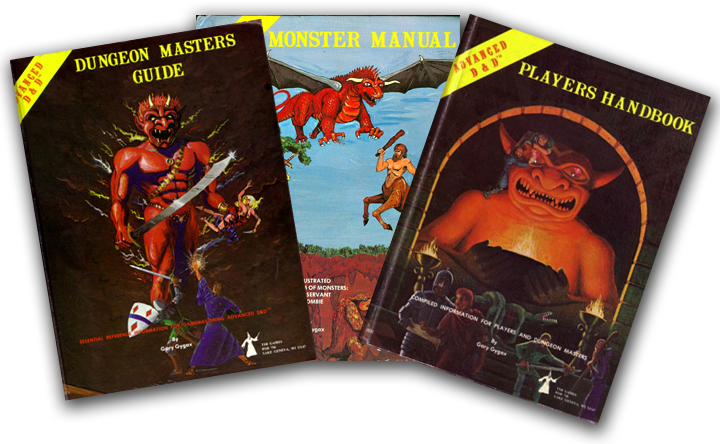
The edition I was first introduced to that weekend in the summer of 1982 was, not surprisingly, 1st edition. It had the lofty moniker: Advanced Dungeons & Dragons (why that word “Advanced” carried with it an almost mythical resonance to me for so long, I still cannot fully explain). When the reissue of the Advanced Dungeons and Dragons core books were released some time last year, I wrote an article about my experiences discovering the game, so I’ll avoid recounting them here. However, those first few years were an interesting time. Like most kids who come into D&D for the first time, I played the game “wrong” for the first two years. Which is to say, we ignored certain rules that we weren’t aware of, didn’t understand, or didn’t like. Characters tended to get extremely powerful very quickly, role-playing wasn’t really a focus, and the world practically rained magic items.
Sometime in late 1983, I began to get more serious about the rules and the game world we were playing in. TSR was the name of the company publishing D&D at that time, and the only campaign setting they had commercially made available was the World of Greyhawk, and I was drawn to it like a moth to a flame.
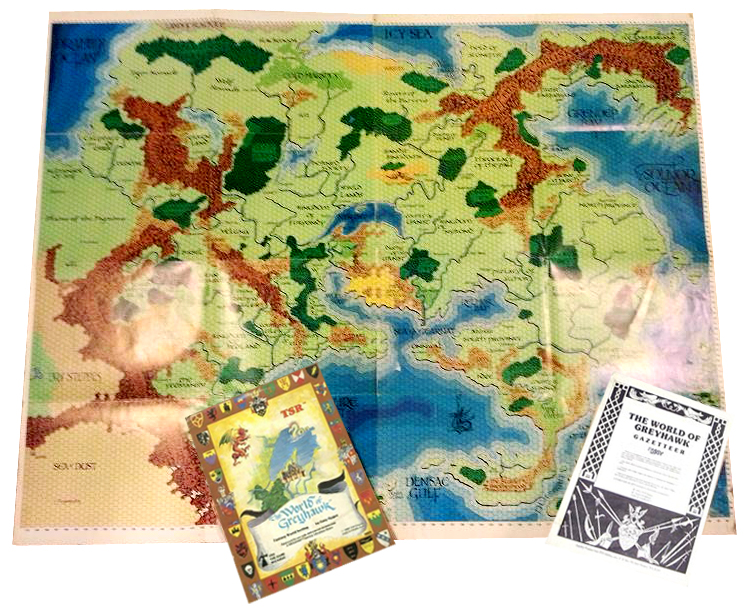
My friends and I had already played a few published adventure modules that had made reference to their location in the World of Greyhawk fantasy setting, so it was intriguing to find where those places were on the large, gorgeous, fold-out maps of Greyhawk’s busiest continent. Greyhawk became my chief love, and pretty much any adventure that I have run since 1983 has been set upon that exalted landscape. This is important to realize, and will help to explain why I view the 4th edition of Dungeons & Dragons to be such an enormous failure (more on that later).
My experience with 1st edition ran the course of about four years (1982-1986). During that time, my friends and I also experimented with the Dungeons & Dragons Basic Set. Early in the article I referred to having played at least one “variant edition.” The Basic Set is what I meant by that. Basic D&D came self-contained in a red box, and covered the character levels of 1-3. I participated mostly as a player in those games, DMing once or twice. Added to Basic Set was a follow-up box called the Expert Set that provided additional rules that allowed for characters up to level 7.
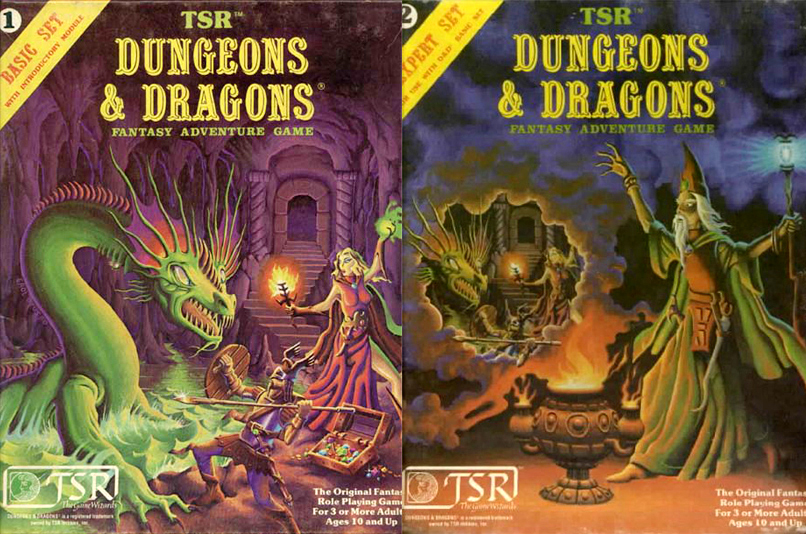
To be honest, while I enjoyed those games, my real enthusiasm was always aimed at the more robust hardcover books of 1st edition. In these early days, I was still struggling to understand and implement the more complicated rules as I slowly waded my way through the oceans of 9-point font that filled the Dungeon Master’s Guide. By 1985 I had read the DMG from cover-to-cover and I believe it’s fair to say that I had “mastered the game.” From about that point forward, I was always the DM.
Second Edition
In 1986, TSR released Advanced Dungeons & Dragons 2nd Edition. There was quite a bit of excitement leading up to the release, but I must admit my initial experience and connection to the books was a bit of a dull thud. The artwork was pretty awful, the writing was rather drab, and a substantial amount of material seemed to have been “cut” from the game. For example, the half-orc and various elven sub-races disappeared as an optional player character race. The assassin and the monk vanished as optional classes. 1st edition had a rough, edginess to it, and 2nd edition seemed to have been run through the keep-it-squeaky-clean machine.
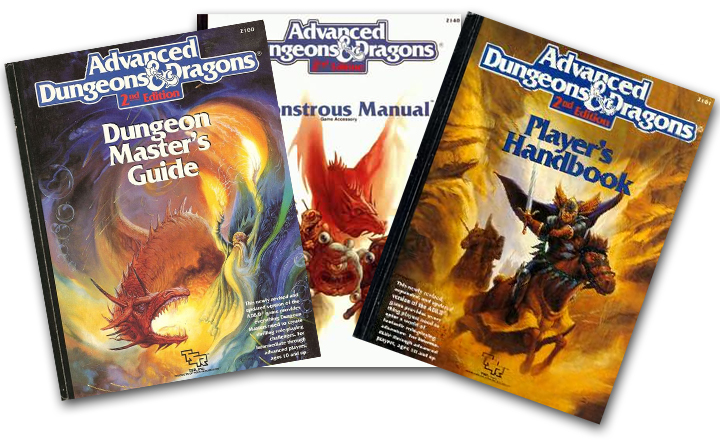
On the other hand, the game rules had certainly been made more immediately approachable. Archaic, nearly indecipherable mechanics like 1st edition’s rules for pummeling, grappling, and overbearing became considerably more sensible (but still awkward). Spells and their effects were homogenized and combat mechanics were significantly improved. Yet, overall, the two editions were largely compatible. A novice observing two games of differing editions played back-to-back probably wouldn’t even notice a difference. I was able to continue to incorporate elements that we liked from 1st edition with little to no effort at all. I was disappointed that the game had been polished so hard that some of its enamel had worn off, but I reminded myself that it was still early in the new edition. Expansion books would likely follow and the old edginess would return. It turns out, I was correct.
My Greyhawk campaign began to take on a much more serious tone during this era. I kept careful track of the passage of time. I utilized every rule as written and intended. We used miniatures to represent battles and dungeon exploration on the tabletop (a rarity in many games at that time). On occasion our gaming sessions would last for two or three days, punctuated only by short breaks to consume food and sleep. More players entered into my campaign setting and a sense of history began to develop. We would discuss old challenges the players had overcome, and deadly enemies yet to be faced. The World of Greyhawk took shape in all of our minds, becoming more rich and detailed and mysterious than any world from a novel or a movie could ever hope to achieve. Our game thrived.
This lasted for years, and my collection of gaming material grew and grew. Those who played during the era of 2nd edition D&D will remember the enormous amount of books that were released. The well known red, soft-cover “complete books” expanded the game for players in many ways. This is really where the notion of character customization concepts really took root. These books introduced a mechanic called “kits” (I still hate that name) that allowed players to receive a series of benefits that would, in theory, be balanced by a series of hindrances. This balancing theory usually resulted in failure, with the benefits or hindrances weighted too heavily one way or the other. Still, it was the means by which assassins, monks, and a host of sub-races returned to the game, and for that, we were happy.
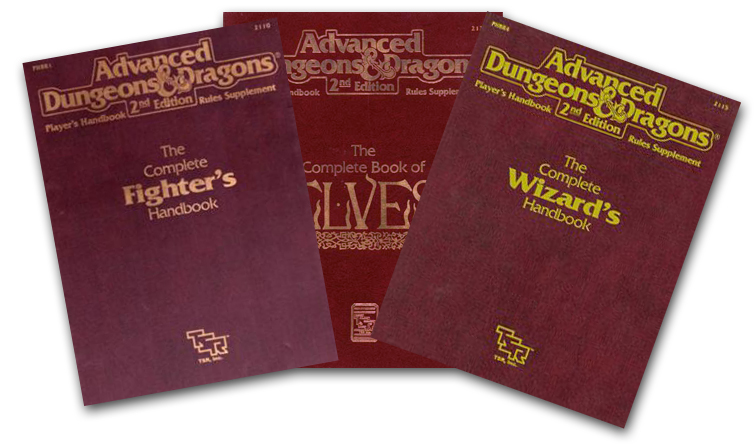
This period represented the longest stretch we have ever had with one edition. For us, the era of 2nd edition lasted from 1986 through 1995. Not bad, I must say. There was a revision during that time, but it was mostly artistic in nature. The terrible blue-stamp artwork of the original books was replaced with a much more palatable selection of color art, and the format of the books was organized better and given a much-improved look.
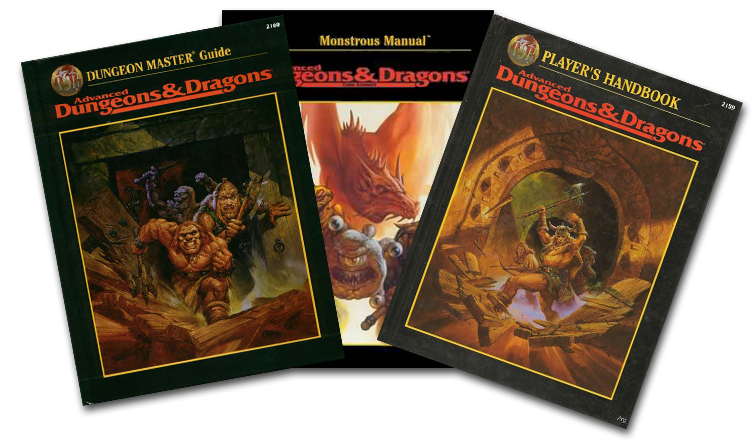
In 1995, the Player’s Option books were released. These were not “officially” touted as a new edition of the game, but for all practical purposes they were. They were instead presented as an optional rules framework that allowed players and game masters to customize D&D in ways that allowed for a freer and yet much more complex play style. A whole book dedicated to a more complex method of running combat was introduced. Another book offering ways for players to create truly customized characters was published. Irritated that your super-genius wizard couldn’t spend a little time learning how to wield a longsword? The Player’s Option: Skills & Powers book had the answer for you. This book was followed shortly thereafter by another tome offering a host of new rules for magic in the game. Why can’t your wizard ever score a critical hit with a fireball? Player’s Option: Spells & Magic gave you the tools to make that happen. Lastly, there was a book offered up that gave rules for DMs to run extremely challenging high level game options. It was a great series (but not without its problems) and we really embraced them.
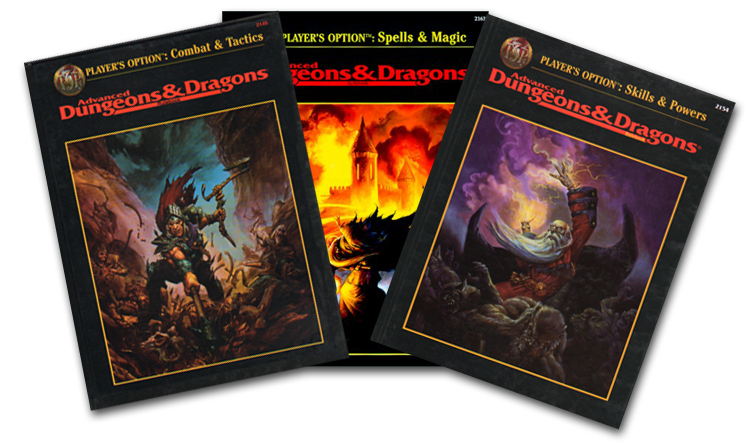
Then, for a variety of reasons, came the first dark period of D&D for me. First and foremost, the material being released for Dungeons & Dragons became increasingly scarce. Worse, the offerings were of poor quality and ultimately of little use. It was clear that something bad was happening to TSR. The Internet was still young in those days, and information leaked a little slower than it does now, but we eventually learned that the company that had produced Dungeons & Dragons for over twenty years was a sinking ship. Rumors of terrible mismanagement trickled down the pipe and the future seemed grim for our favorite game.
Additionally, most of the members of my long-standing gaming group had far less free time than we did in our younger days. College, jobs, relationships; all competed for people’s time, and adventures in the World of Greyhawk grew quiet. There were no local game stores for me to seek new players. No localized message boards for me to post “gamers wanted” ads. For a time, D&D seemed like it might need to be retired. Perhaps we’d dust off the old books someday when people were less busy and continue our saga.
Then word began to circulate that TSR had been sold to a company called Wizards of the Coast, the makers of the increasingly popular card game called Magic: The Gathering. In short time we also learned that a 3rd edition of D&D was in the making! As the Internet had become much more of an entity in everyone’s life we were able to follow the unfolding journey of D&D more closely. In 2000, some friends and I took the trip to Gen Con in order to be among the first people to get their hands on the new edition of the game.
We were not disappointed.
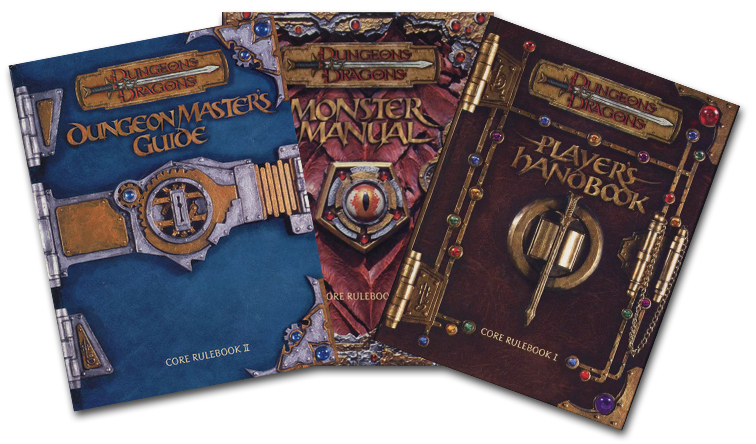
A new era
3rd Edition was exactly what we wanted. A wonderfully written set of rules, an enormous amount of options, a rekindling of Greyhawk right in the core rulebooks, and the promise of a bright future for our favorite game in the hands of a successful company. What’s more, the edition was very backwards compatible. With no real trouble at all, we managed to convert all of our old characters from previous editions to the 3rd edition rules. To our surprise (and as a testament to the 3rd edition’s versatility) the characters played very much like they had in 2nd edition. My long running Greyhawk campaign flourished once more and the detailed timeline of heroic events continued.
After two short years of gaming, Wizards of the Coast announced a revision to 3rd edition. It was met with audible groans from the collective online gaming community. It was perceived as a money-grab by Wizards, and everyone seemed indignant about shelling out more money to buy the core books all over again after only two years of usage. Personally, I welcomed the change. It was evident from our experience with playing 3rd edition that certain elements were “broken.” Anyone who was an active player during this period will know what I’m talking about. Power creep, as it has come to be known, was a real problem for most experienced gaming groups. Feat combinations and exponential stacking of spell effects made life hell for Dungeon Masters who wanted to provide a challenging game for his or her players. The revision was heralded as D&D 3.5 and after it was finally embraced by the masses everyone was forced to concede that the improvements to the game were worth the cost of buying the books again.
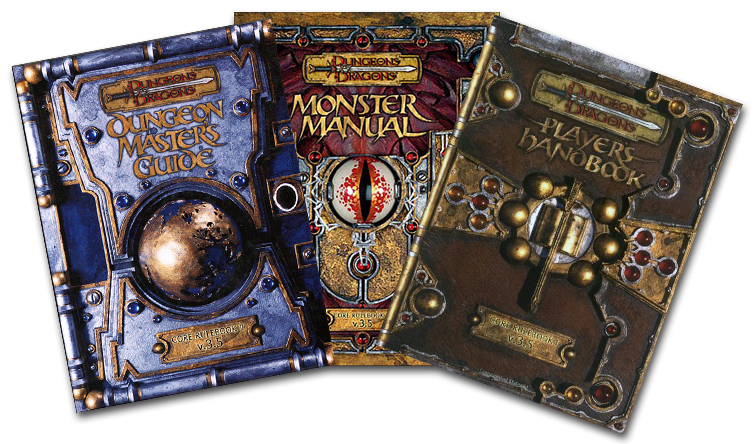
This era was important to me for a number of reasons. Not only was my Greyhawk campaign flourishing once more, my potential player base expanded into the unlimited range. I opened Battleground Games & Hobbies in November of 2002 and my involvement in my lifelong hobby became my business as well. The reign of 3rd edition D&D was a positive chapter in my D&D experience. Lots of great games were played and a host of new people became familiar with my old campaign, which by this time was over twenty years old.
Yet something happened again to thwart my enjoyment of Dungeons & Dragons. It began sometime after 2005, and it wasn’t obvious at first. By that time, many books had been added to the repertoire of tools for players to use in building their characters. Once again, D&D offered up a new series of “complete” books (this time in hardcover), presenting a variety of new options for them to choose as part of their character building process. These options did not always balance well, and it was extremely dubious as to whether or not any of them had been play-tested at all prior to the print release of the book.
Once more, it became difficult for DMs to provide balanced challenges for the player group. Characters became incredibly powerful and veteran players were amazing at having an answer for any and all foes they might face. Furthermore, the connection between players and the rules strengthened more than it had in previous editions. With their deep and expanding knowledge of the customization options available for players to utilize, control of the game could very easily slip out of the hands of the Dungeon Master, who was in all previous editions responsible for such things. This isn’t to say that good games couldn’t still be had. Every gaming group wants different things out of their game. But I stand by the notion that true mastery of D&D had transferred hands from DM to the player at a certain point after 2005. Something in the mystery of the game had been lost. That element of wonder and surprise was greatly depleted, and in my opinion, it came at the cost of immersion in the game world.
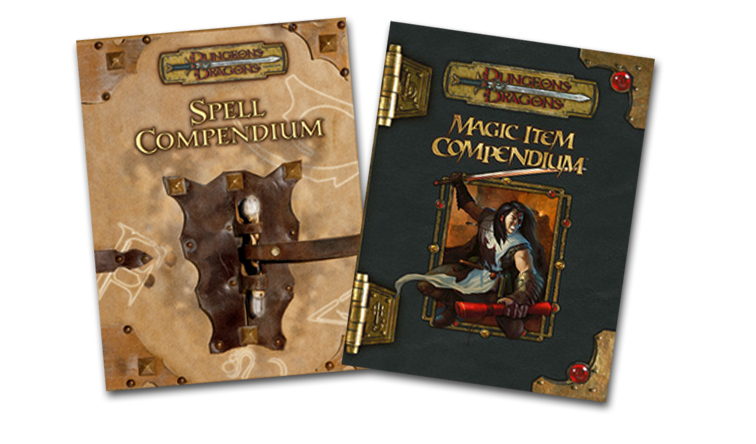
Nowhere was this more evident than in the release of two books which I feel rang the death knell for 3.5 D&D: The Spell Compendium and the Magic Item Compendium. The former introduced certain spells into the game that simply made the DMs job of providing balanced and challenging encounters infinitely more difficult. Certain spells in particular sounded suspiciously like they were written by a player best described by the now famous adjective: “munchkin.” Elemental Body anyone? Benign Transposition? Bombardment? Perhaps these problem spells were exclusive to my campaign. I’m sure worse examples can be culled from the tome, but my point should be clear. It used to be that the players had to react to challenges put forth by the DM. This makes the game exciting and realistic. By late 3.5 DMs were forced to constantly be reacting to challenges posed by the player’s and their characters. This had a distinctly negative impact on the immersion in the game.
For the latter example of the two books I cited above, consider this passage from the Magic Item Compendium:
“A player points to an item published in this book or the Dungeon Master’s Guide and asks, ‘Can I buy this?’ The answer should usually be, ‘Yes.’”
I remember blinking erratically for a few minutes after reading that passage as I realized with sudden impact that the game had slipped from my grasp. Beyond recovery? No, but I would certainly need to begin the struggle of reclaiming the game and restoring its lost verisimilitude. Modern players might not understand the reasons why a full and comprehensive knowledge of D&D’s enormous offering of magic items is a bad thing for most games. It’s harder to see when you come to the hobby through games like World of Warcraft or Diablo III or any other such game that treats magic items as less of a special thing and more a part of the intrinsic and essential part of the adventurer’s economy.
I realize the inherent absurdity in making the claim that an economy built on the buying and selling of magic items interferes with the realism of the D&D campaign. Is imagining an economy for magic items really that silly in a world where dragons rain fiery death from the skies, wizards shoot lightning from their fingertips, and adventurers live through a 50’ fall into a pit filled with poisoned spikes? Yes. Yes, it is. Perhaps in some future article, I’ll explain my reasons for holding that opinion. For now, I’d like to bring this tale to the end of 3rd edition, and into the D&D blackout of 4th edtion.
Fall from grace
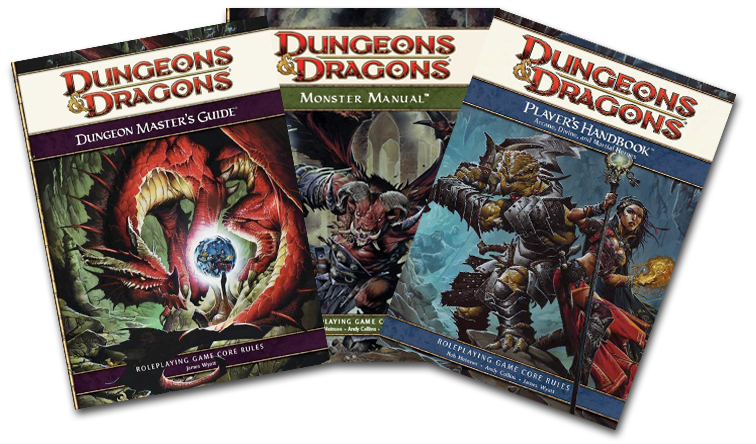
What can be said of 4th edition that hasn’t already been blogged about ad nauseam? When the news of 4th edition hit the gaming stratosphere, people were not ready for it. This was the least of the editions problems, unfortunately. After all, people weren’t ready for 3.5 either, but it worked out just fine in the end. It was recognized then that solid changes were made to the game that resulted in a superior product and play experience. From early on, there were inklings that 4th edition was heading down the wrong road. Many months before the release of the edition, Wizards published a sneak-peek series of books that gave us our first view of some of the philosophy and design concepts that were being implemented in the new edition. I distinctly recall this passage rankling some feathers in Battleground when it was pointed out by one of our regulars:
“…when’s the last time you saw a PC make a Profession check that had a useful effect on the game? (Hint: If it was recently, your game is probably not as much fun as D&D should be. Sorry.)”
Here, we had a designer of the new edition telling players and DMs that enjoyed the idea of Profession checks in their campaigns that they weren’t having as much fun as they should be at the gaming table. Clearly, a game that once allowed for an enormously broad style of play was being directed to one particular style. To me, this is the equivalent of someone telling me that watching the Godfather films and enjoying the deep character development and sense of realism and tempered pacing is “less fun” than the latest, fast-paced trope from Michael Bay with its neat explosions and furious, hyperactive action.
As the release drew nearer, there was more troubling hints. Magic items now would be appearing in the Player’s Handbook for players to purchase and sell at will. In fact, doing so was an essential part of character leveling. Iconic character races and classes were being removed from the game and replaced with other, weirder and more fantastical races (dragonborn & tieflings). There was “DM advice” advocating the collection of magic item “wish lists” from all your players so that you could insert these items into the adventure for them to get the “kewl loot” they want. I futilely hoped that these ill tidings would not amount to an insurmountable problem.
The edition was a failure. Even in ways I had not anticipated.
Sales for the edition began strong as people desired to give it a fair shot. Games were played on the regular and Wizards instituted the Wednesday night D&D Encounters program to help get new players into the store and playing D&D. From a business standpoint, the merits to this type of game are obviously high. A system for people to show up to a store and be able to jump right into a game and start playing D&D is very good for exposing more new players to your product. But what about the old players? The ones who had been with the game since 1982 and beyond? Due to the extreme differences to how characters were constructed and functioned in the game, it was virtually impossible to convert characters from previous editions of the game to the new edition and have them play anything like they did before. “Yes, we are aware of this,” came the response from the D&D design team. “That’s why you should retire those characters and your old campaigns and start a brand new one using the 4th edition rules.”
For someone with a twenty-five year investment in their D&D campaign, these suggestions were the equivalent to telling me not to bother playing the game at all. Even still, I gave the game a fair shot. I “paused” the exploits of the players actively participating in my other games and started a new group adventuring in lands far away from the continent of my typical campaign setting.
It crashed and burned fairly quickly. It was crystal clear that this version of D&D was not for me (or for my players). It was a sinking ship right from the start, though we certainly gave it a solid try. I’ve touched on a few of the problems I had with the edition here and elsewhere. Online, the residual effects of the great 3rd vs 4th edition war still carries on. For me, the edition was dead within the first year of its release in 2008. There was a brief attempt to save the flailing edition in 2010 with the D&D Essentials revision, but it resulted in little more than a feeble whimper.
So where did I turn for my gaming fix? If you’ve come this far you must know that I would eventually mention Pathfinder.

Pathfinder is 3.5 Dungeons & Dragons with a different name and some minor tweaks to the core rules. It’s often jokingly (and accurately) referred to as D&D 3.75. I like to refer to it as a “legally stolen game.” Upon the release of the D&D 3rd edition rules, there was a revolutionary and daring document provided by Wizards of the Coast that allowed any publisher to produce material for the D&D game system, up to and including the reprinting of a significant portion of the actual rules themselves. This document, called the Open Game License, was a huge boon for 3rd edition at the time. It effectively created a guaranteed dominance in the role-playing game industry that kept Wizards of the Coast firmly established at the top. Ironically, this same innovation would ultimately work against them in equal portions when 4th edition D&D began to fail.
A company called Paizo, originally the authorized publishers of Dragon Magazine and Dungeon Magazine, using the Open Game License as their defense, reprinted and rebranded the Dungeons & Dragons role-playing game as if it were their own. At first, its popularity was a small, sizzling flame, but as D&D 4th edition began to collapse, it rose to dominate the number one sales spot in the RPG industry. For the first time ever, the Dungeons & Dragons brand name had been usurped by another brand. Paizo puffed their chest about this quite frequently, which always rubbed me the wrong way. After all, this truthfully was not their game. When you are playing Pathfinder, you are playing a version of Dungeons & Dragons 3rd edition.
Still, Pathfinder was the best of the available options for my game for the past four years or so. Some of the tweaks to the core rules were minor improvements over the 3.5 rules. Yet the large problems with 3rd edition’s ridiculous magic-item driven economy, player character power-creep, and issues with a DM’s ability to properly present challenges at higher levels all remained. These problems could not be fixed without a more proper treatment to the rules system.
My feeling is that we are about to get that treatment.
Dungeons & Dragons – 5th Edition
After the announcement of D&D 5th edition, I decided to put all my games on hold. It’s been over a year since I’ve run a game in my World of Greyhawk campaign. I’m pretty sure it’s the longest I’ve gone without running a D&D game since it all began back in 1982. I took the break for several reasons, but mostly it was because I realized that there just didn’t seem to be an edition for me anymore. 1st edition was great in its day, but too much had changed for me to step that far back into those archaic rules. 2nd edition had appeal briefly, but again, too many really solid improvements had been made in areas that really mattered for me to return to the magic of that era. 3rd edition’s problems were just too close to home for me to pick up and try again. These problems, having not been addressed to my satisfaction in 3.5 and Pathfinder ruled those choices out too. 4th edition wasn’t even considered.
To be fair, each edition, even the much maligned 4th edition, taught me something about what makes for a great D&D game. Immersion is the key. Good, solid rules, but not too many of them! Keep the math to a minimum while you’re actually at the table. Too many modifiers, too many combos and considerations, and you only succeed in pulling everyone out of the moment. We need a game that allows for adjustable speeds, so it can be tailored to each individual group. Restoring that lost sense of mystery to the game is essential too (keep those magic items in the DMG!). We need an edition that plays well at higher levels, so that when the time comes to pursue your worst enemies into the Abyss itself, you’ll have a good time doing it.
Based on the spoilers that I’ve seen so far, and the inside track I’ve been following on the Internet, it seems very likely that we might finally get the best edition of D&D yet. To me, it seems like a giant, positive step backward. Yet in the taking of that step the designers have raked back with them all of the best concepts and innovations that were presented in the later editions (and added a few new ones). In just a few more days we’ll have our first real peek at what the new edition will look like with the release of the Dungeons & Dragons Starter Set. It will be available at both Battleground locations on July 3rd, just in time to blow off all your 4th of July plans and spend it consuming the contents of the boxed set.
My Greyhawk campaign is about to begin again. Rising up and out of the ashes of the brutal Edition Wars.
May those wars finally be at an end.
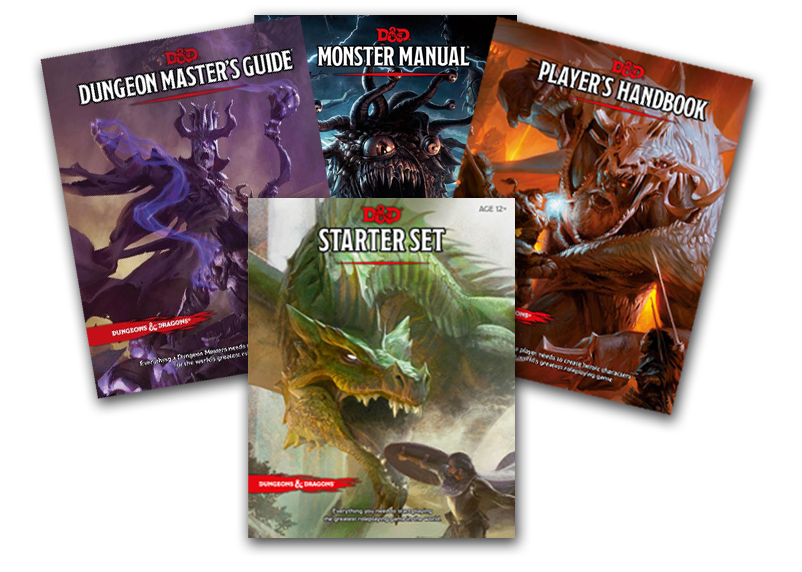
Click on the image to preorder the Dungeons and Dragons 5th edition books and set!
Afterword
I am aware that I failed to mention the Original D&D folio booklets that were first published in 1974. This is for two reasons. The first is that I have only ever played them in a one-shot, retro style game. The second reason is that while they certainly hold a classic charm, they are more or less inferior to the much larger works that came later.
About the Author
Derek Lloyd is the owner of Battleground Games & Hobbies. He is a lover of games and a hater of all things Michael Bay. When he’s not behind the counter working hard to satisfy the needs of his customers, he can usually be found socializing and painting miniatures or terrain at the rear of the store. Besides games, he is also a fan of film, well thought-out discussions, and long walks on the beach. If anything was left out of this bio, then you can blame Sims because he’s the one who wrote it.
Join the Battleground Games & Hobbies community forums!
Please don’t forget to check us out on Facebook and follow us on Twitter @battleground_gh!

Tags: 5th edition, Derek Lloyd, Dungeons and Dragons, edition wars, fifth edition, tsr, Wizards of the Coast
Posted in Blog, Dungeons & Dragons, Featured Author, Featured Post, Popular Posts, Role-Playing Games, Store Related | 4 Comments »

Tuesday, April 15th, 2014
There is simply no question that the hardest the Battleground staff works all year long is the week leading up to and through PAX East weekend. For the show to go off so well, we need everyone giving their all, and this year we were blown away with how much effort our staff and volunteers put in.
I’d like to begin by thanking Chase, without whom our PAX presence (and so much of what Battleground does) just couldn’t happen. Considering the industry we work in, it seems perfectly acceptable for me to quote Star Trek in how I feel about Chase: “[I] feel safer about [his] guesses than most other people’s facts.” His organizational skills, researching ability, and limitless drive are what set the pulse of Battleground.
To the entire staff of Battleground, I give my thanks. For those of you that take the journey with us to the show and manage to remain on your feet all day long and never lose the capacity for a smile, a conversation, or an opportunity to help someone find the perfect game, I am so grateful for your presence and your dedication. To the staff that remains behind to hold down the fort at our Abington and Plainville locations, you also deserve high praise. Your sacrifice of not attending the show in order to put in long hours over the weekend does not go unnoticed!
To the volunteers who give so much effort to help us do what we do at PAX East, I am utterly humbled by your stamina. Before I even needed to open my mouth to ask one of you for help, you were already there. Without your command of the Tabletop Hall, the PAX East gaming convention would be a lesser show. How many people leave with memories of the great time you showed them with nothing more than your love of playing games? We are so proud of how much you give to the people who attend the convention. Teaching games until your voice is hoarse and scoffing at the notion of sleep – you are why we succeed.
And finally, to those who come to spend time with us at our booth and with our demo team, we thank you for your company and support. We are grateful for your friendship and for being a part of our shared enthusiasm for all things gaming.
I can’t believe I’m saying this, as I still haven’t shaken off the exhaustion from the weekend, but I already can’t wait for next year!
Thank you so much!
Derek
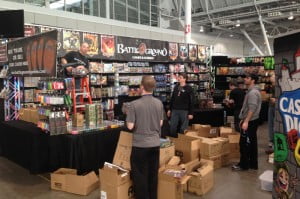
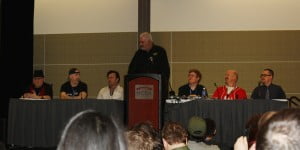
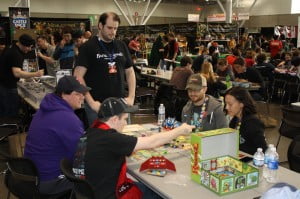
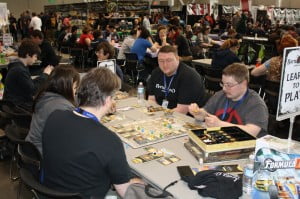
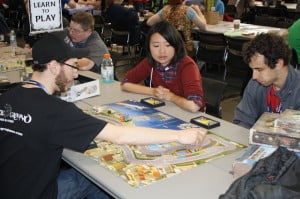
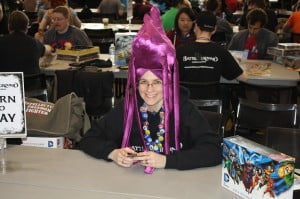
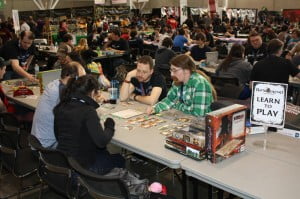
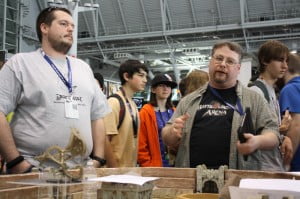
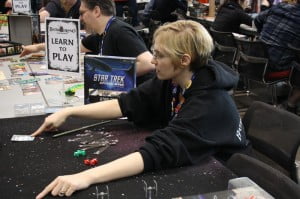
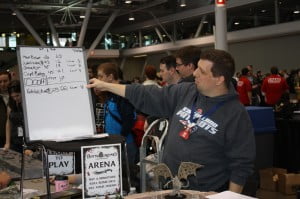
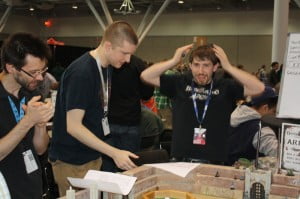
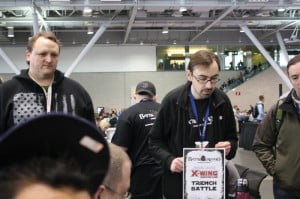
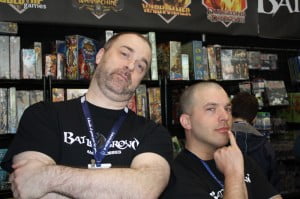
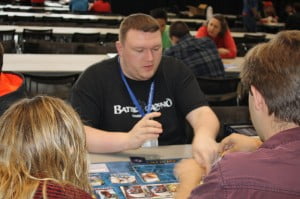
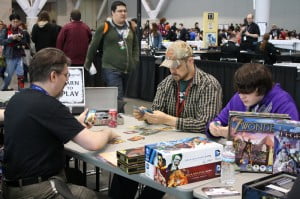
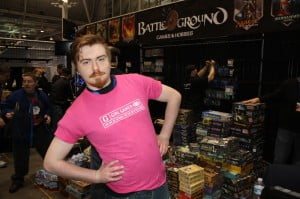
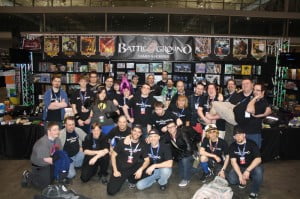
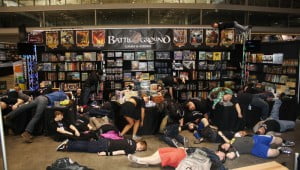
Tags: Derek Lloyd, PAX East 2014, Thank You
Posted in Blog, Board Games, Card Games, Events, Featured Author, Featured Post, Popular Posts, Role-Playing Games, Store Related | 6 Comments »

Wednesday, October 2nd, 2013
“Deities, Demigods, and Small Folk”
Paul S. Kemp Discusses New Forgotten Realms Novel in The Sundering Series: The Godborn
Interview by Alfred O. Cloutier

Battleground Games: You’ve stated that The Sundering isn’t a retroactive continuity fix, but it does appear to be a philosophical reversal, a looping back to Forgotten Realms’ “essence.” What is this essence and how was it lost?
Paul S. Kemp: “Lost” overstates things, I think. I’d say the Realms wandered a bit off the path for a while, experimented with psychedelics, joined a commune, tried out multiple marriage, and, well, it wasn’t all it had hoped.
To me, the Realms is a classic fantasy setting and – and this is important – it’s rooted in optimism and permeated with an exuberant sense of adventure. Now, that doesn’t mean it’s all unicorns shitting rainbows – far from it – but it does mean its core is, in the end, hopeful. It has a dark side, of course (every book I’ve written in the Realms explores that dark side) but the darkness doesn’t define the setting and hopelessness is not the keystone. Hope is at the foundation of the realms, optimism, a glorious sensawunda.
BG: Do you think the changes made to Forgotten Realms for 4th Edition D&D were positive for the overall popularity and growth of the campaign world?
PK: I honestly don’t know. I think on balance it *probably* wasn’t good for the popularity of the setting, but I’m on the outside looking in, so that’s speculation. In terms of growth, though – there’s a shitload of great material and development that came out of 4E (e.g. the development of the Dragonborn). So there were (and are) some quite excellent aspects of 4E that enriched the setting.
BG: You intended The Godborn to be a trilogy, but it has been folded into The Sundering series. How did that change the way you wrote the story?
PK: It actually didn’t change much at all (other than making it longer). I’d outlined the first book in the proposed trilogy and had a pretty firm notion about where I wanted the trilogy to end up (though I hadn’t gotten into the details of how I’d get there). In the end, I found that telling that story in one, longer book, worked exceptionally well.
BG: Are there details, storylines, characters, etc. hidden in this arc that couldn’t come out because of space restrictions?
PK: There weren’t, no, for the reasons I just rambled about above.
BG: Do you have a formal metaphysics for Forgotten Realms, i.e., do you have a guide as to what interactions are for “souls,” “spirits,” “gods,” and “mortals?” [I always loved the old Basic D&D to Immortals path, and from looking at some FR materials, it looks like this type of path is used in the campaign world.] For example, does every PC race have a “soul” and a “spirit?” What happens to these when they die?
PK: Well, the Realms has its own metaphysics and I don’t mess with them much. My job (when my stories have need for it) is to make them mysterious and wondrous. I did this with a scene at the end of MIDNIGHT’S MASK (the last book of the Erevis Cale Trilogy) and it seemed to resonate strongly with readers. I’m being vague here in the interest of avoiding spoilers.
BG: Why is it the case that “dark heroes” seems to resonate with audiences? Batman, Drizzt Do’Urden, Ari Marmell’s Widdershins and your Erevis Cale, rogue antagonists are very popular, why is that?
PK: You think Drizzt is a dark character? I think of Drizzt an archetypical heroic character. Entreri is a different kettle of fish, of course.
Anyway, I don’t think whether a character is dark or light has much relevance to popularity. Superman’s popular, after all. Whether the character is compelling is the point. At any particularly time, there’s always a lot of dark characters who are popular and a lot of noble/light characters who are popular. What they all share, I suspect, is that they’re compelling.
Now, that said, I think there are sometimes sentiments afoot in the zeitgeist that make one kind of character (dark or light) resonate with the audience more readily. So, when world events have featured a recent atrocity, and folks are feeling fearful, or in need of vengeance, you might see dark heroes a bit more popular than would be otherwise. But eventually that fear or need for vengeance passes and you see the counter movement – an open desire for a more hopeful future, which is reflected (to some degree) in a noble/light character.
BG: Is Vasen Cale going to be a dark hero? How did you go about developing his character?
PK: He has elements that are dark, but Vasen is more in the vein of noble character. He’s self sacrificing and, in some ways, an idealist. He has his father’s blood, of course, and that creates some internal conflict for him, but he’s very grounded in his faith and the fact that shadows bleed from his flesh is not going to shake that grounding.
In terms of how I developed him: I did it she same way I do with every character. I create the relevant facts of his background (in Vasen’s case: He’s Erevis Cale’s son, but was raised in relative isolation among an elite order of holy warriors who serve the God of the Sun) and build a fairly detailed psychology for him from there.
BG: It’s been said that an author can’t transcend their own intellect with characters (it’s impossible to write a character smarter than yourself). I don’t necessarily agree with this, but how do you personally write from the perspective of a demigod, or a deity?
PK: That’s a weird thing for someone to say. And if it were true, we wouldn’t have Sherlock Holmes, since I’m sure Conan Doyle didn’t have Holmes’ IQ.
The simple fact is that authors construct the reality through which the characters move, and and to give the impression of great intelligence to a character, an author need only have them see more deeply into events, better anticipate the moves of their adversaries, etc., and authors can do that because they built the events and the various characters’ responses to them.
BG: Will your book be one of the stories about the “iconic heroes” involved with The Sundering, or will it be more about regular folk “trying to get by?”
PK: Both, and that by design. Riven and Telamont and Rivalen are probably iconic, and they provide the story with the broad, panoramic view that such powerful folks often take. Vasen, Gerak, and Orsin, on the other hand (all of whom are new characters, first introduced in this novel) take a smaller, more personal view. The dynamic between the two types of characters is fun to write.
BG: What is it about Forgotten Realms that attracts you, and inspires you to write in this world?
PK: First and foremost the sense of exuberant adventure I mentioned above. I love that. I love it’s detail, it’s richness, and I love that despite all that detail and richness there are innumerable areas and corners of the Realms in which an author can elbow out some space of their own and build something new. It’s just a lot of fun.
BG: Go through your typical day of writing. How early do you get up, how many hours do you write, how many times you do throw the tennis ball against the wall?
PK: I have a dayjob, so I tend to write in the evenings after the kids go to bed. There’s no magic to it. I grab a whiskey, sit in my library and start writing. That’s about it.
http://paulskemp.com
Paul S. Kemp is a graduate of the University of Michigan-Dearborn and the University of Michigan law school. When he’s not writing tales in Ed Greenwood’s magnificent brainchild, he practices corporate law in Detroit.
Alfred O. Cloutier has contributed to Dragon Magazine, and has edited for a number of other gaming publishers. He can be found at Facebook.com/blaulb.
Posted in Blog, Dungeons & Dragons, Featured Post, Role-Playing Games | No Comments »
 Next Page »
Next Page »







































Social: